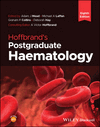Acquired aplastic anaemia and paroxysmal nocturnal haemoglobinuria
Austin G Kulasekararaj
King's College Hospital/King's College London, London, UK
Search for more papers by this authorNeal S Young
National Heart, Lung and Blood Institute, National Institutes of Health, Bethesda, MD, USA
Search for more papers by this authorJudith CW Marsh
King's College Hospital/King's College London, London, UK
Search for more papers by this authorAustin G Kulasekararaj
King's College Hospital/King's College London, London, UK
Search for more papers by this authorNeal S Young
National Heart, Lung and Blood Institute, National Institutes of Health, Bethesda, MD, USA
Search for more papers by this authorJudith CW Marsh
King's College Hospital/King's College London, London, UK
Search for more papers by this authorAdam J Mead PhD, FRCP, FRCPath, FMedSci
Haematopoietic Stem Cell Biology Laboratory, Medical Research Council Molecular Haematology Unit, Medical Research Council Weatherall Institute of Molecular Medicine, University of Oxford, Oxford, UK
Search for more papers by this authorMichael A Laffan DM, MRCP, FRCPath
Department of Immunology and Inflammation, Faculty of Medicine, Imperial College London, London, UK
Search for more papers by this authorGraham P Collins DPhil, FRCP, FRCPath
Department of Haematology, Oxford Cancer and Haematology Centre, Oxford, UK
Search for more papers by this authorDeborah Hay DPhil, MRCP, FRCPath
Nuffield Division of Clinical Laboratory Sciences, Radcliffe Department of Medicine, University of Oxford, Oxford, UK
Search for more papers by this authorA Victor Hoffbrand MA, DM, FRCP, FRCPath, FRCP (Edin), DSc, FMedSci
Emeritus Professor of Haematology Honorary Consultant Haematologist
University College London, London, UK
Royal Free Hospital, London, UK
Search for more papers by this authorSummary
Acquired aplastic anaemia (AA) is a rare immune mediated bone marrow failure characterised by hypocellular bone marrow and pancytopenia. It is a diagnosis of exclusion and is closely associated with disorders like paroxysmal nocturnal haemoglobinuria (PNH) and myelodysplastic syndrome. Good supportive with transfusion support and anti-infective prophylaxis is critical. The two main treatment options for aplastic anaemia (AA) are allogenic haemopoietic stem cell transplant or immunosuppressive therapy with horse anti-thymocyte globulin with cyclosporin and eltrombopag, based on disease severity, age, availability of HLA compatible sibling donor and comorbidities. Symptomatic PNH associated with haemolysis and/or thrombosis is managed with anti-complement therapy, which mainly targets the complement C5 protein and has led to marked improvement in prognosis.
Selected bibliography
- Brodsky RA ( 2021 ) How I treat paroxysmal nocturnal hemoglobinuria . Blood 137 ( 10 ): 1304 – 9 .
- Hillmen P Szer J , Weitz I et al . ( 2021 ) Pegcetacoplan versus eculizumab in paroxysmal nocturnal hemoglobinuria . The New England Journal of Medicine 384 ( 11 ): 1028 – 37 .
- Kulasekararaj AG Jiang J , Smith AE et al . ( 2014 ) Somatic mutations identify a subgroup of aplastic anemia patients who progress to myelodysplastic syndrome . Blood 124 ( 17 ): 2698 – 2704 .
- Kulasekararaj AG Hill A , Rottinghaus ST et al . ( 2019 ) Ravulizumab (ALXN1210) vs eculizumab in C5-inhibitor-experienced adult patients with PNH: the 302 study . Blood 133 ( 6 ): 540 – 9 .
- Marsh JC , Kulasekararaj AG ( 2013 ) Management of the refractory aplastic anemia patient: what are the options? Blood 122 ( 22 ): 3561 – 7 .
- Peffault de Latour R Kulasekararaj A , Iacobelli S et al . ( 2022 ) Eltrombopag added to immunosuppression in severe aplastic anemia . The New England Journal of Medicine 386 ( 1 ): 11 – 23 .
- Risitano AM , Peffault de Latour R ( 2022 ) How we('ll) treat paroxysmal nocturnal haemoglobinuria: diving into the future . British Journal of Haematology 196 ( 2 ): 288 – 303 .
- Townsley DM Scheinberg P , Winkler T et al . ( 2017 ) Eltrombopag added to standard immunosuppression for aplastic anemia . The New England Journal of Medicine 376 ( 16 ): 1540 – 50 .
- Yoshizato T Dumitriu B , Hosokawa K et al . ( 2015 ) Somatic mutations and clonal hematopoiesis in aplastic anemia . The New England Journal of Medicine 373 ( 1 ): 35 – 47 .
- Young NS ( 2018 ) Aplastic anemia . The New England Journal of Medicine 379 ( 17 ): 1643 – 56 .



